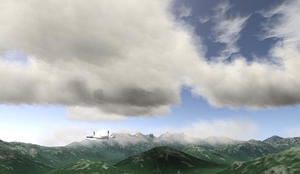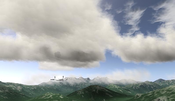Information
- Publication Type: Student Project
- Workgroup(s)/Project(s):
- Date: 2014
- Date (Start): 9. October 2012
- Matrikelnummer: 0726417
- First Supervisor: Michael Wimmer
- Keywords: real-time rendering, cloud rendering
Abstract
Rendering of clouds, atmosphere, and other natural phenomenon is an important topic in computer graphics. In this technical report, we present a novel solution, which uses different techniques to generate a realistic representation of the sky. We present a billboard-based approach to create clouds. We use half-angle slicing to generate volumetric shadows. The resulting shadow map is then used for casting shadows on the terrain, the clouds, and other objects. We also use and compare different atmosphere models and providing light shafts. Furthermore, CloudyDay provides HDR mapping, a bloom effect, colour grading as well as some natural phenomenon like rain. We develop CloudyDay to test an autonomous flying robot. We present several enhancements, which consider the specific requirements of this specific application area. All objects can be created by an artist. This is great workflow, if a specific test-case should be created. However, creating a lot of different variations of an object is a time-consuming task. A more reasonable way is to create the shapes with procedural modelling. This technique enables to create objects (in this paper clouds, atmosphere,...) and vary the representation by varying the parameters.Additional Files and Images
Weblinks
No further information available.BibTeX
@studentproject{BEHAM-2014-RCR,
title = "CloudyDay: Rendering of clouds, atmosphere and light shafts
in HDR for testing Computer Vision Algorithms",
author = "Michael Beham",
year = "2014",
abstract = "Rendering of clouds, atmosphere, and other natural
phenomenon is an important topic in computer graphics. In
this technical report, we present a novel solution, which
uses different techniques to generate a realistic
representation of the sky. We present a billboard-based
approach to create clouds. We use half-angle slicing to
generate volumetric shadows. The resulting shadow map is
then used for casting shadows on the terrain, the clouds,
and other objects. We also use and compare different
atmosphere models and providing light shafts. Furthermore,
CloudyDay provides HDR mapping, a bloom effect, colour
grading as well as some natural phenomenon like rain. We
develop CloudyDay to test an autonomous flying robot. We
present several enhancements, which consider the specific
requirements of this specific application area. All objects
can be created by an artist. This is great workflow, if a
specific test-case should be created. However, creating a
lot of different variations of an object is a time-consuming
task. A more reasonable way is to create the shapes with
procedural modelling. This technique enables to create
objects (in this paper clouds, atmosphere,...) and vary the
representation by varying the parameters. ",
keywords = "real-time rendering, cloud rendering",
URL = "https://www.cg.tuwien.ac.at/research/publications/2014/BEHAM-2014-RCR/",
}

 report
report


